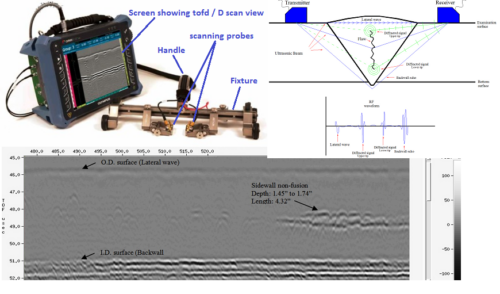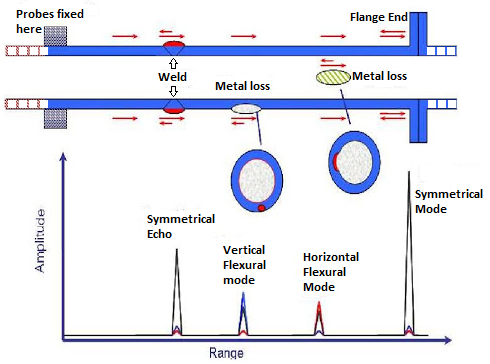In a world full of technological wonders, NDT ensures the safety and reliability of the structures and materials on which we rely. Ultrasonic Testing Methods is a fascinating realm where sound waves play the leading role in NDT. Ultrasonic Testing is an NDT Method that uses ultrasonic waves to inspect materials without causing harm.
These waves penetrate materials, revealing internal structures and defects without a scratch. The tester sends ultrasonic waves into the material, setting the tone, and when a flaw is detected, it bounces back, revealing its location and size, similar to a musician detecting a sour note. Ultrasonic Testing comprises a few methods that are used to determine any flaws or irregularities in any material. Check them out.
What are the Advanced Ultrasonic Testing Methods in NDT?
In ultrasonic testing, each type plays a distinctive role, in ensuring the examination of materials. Whether it's the gentle touch, the deep dive, or the precision of phased arrays, ultrasonic testing methods offer a diverse range of tools for flaw detection.
Latest Inventions have given us advancement in technology, a few are given below:
- Phased Array Ultrasonic Testing ( PAUT )
- Time of Flight Diffraction Ultrasonic Testing ( TOFD )
- Long Range Ultrasonic Testing ( LRUT )
- Automated Ultrasonic Backscatter Technique
- Internal Rotating Inspection Systems
- Dry-Coupled Ultrasonic Testing
- Rapid Ultrasonic Gridding (RUG)
- Conventional Ultrasonics
1. Phased Array Ultrasonic Testing (PAUT)
A Phased Array Ultrasonic scanning unit involves many crystals arranged in a manner that sends sound waves in different directions inside the material. The sound from different crystals is timed by the computer at different phases – hence the name Phased Array (Timed elements & Arrangement of elements)
The major advantages of the technology are:
- Inspection is quick since the manual to and fro movement by the user is not required.
- More possibility of finding defects without using different angle probes, since a single probe scans in different directions.
- PAUT gives multiple views of the defects through advanced presentation views such as B scan (depth of defect) view, C Scan View(Top view), S Scan view (sectorial view), and conventional A scan view (echo pattern ).
Complete scanning can be recorded and interpretation can be made later by many people. So the technology is believed to be a reliable process for inspection.
Read More, Phased Array Ultrasonic Testing: What, How & Where
2. Time Of Flight Diffraction (TOFD)

The technology is used for Crack detection at a rapid rate. The method involves two Ultrasonic probes a “transmitter’ and a “receiver” attached to a fixture. The fixture can be operated manually or robotic. The technology finds defects by analyzing the time of sound travel and sound diffracted from the crack tips, hence the name “ Time of Flight Diffraction” The technology exactly locates the defect and measures the size of the defect.
3. Long Range Ultrasonic Testing / Guided Wave Testing

The Technology is used to scan a complete length of pipe for internal corrosion, cracks, or damages. Long Range Ultrasonic Testing involves multiple Probes fixed around the circumference of the pipe. The sound is sent in a manner that travels through the wall of the pipe up to the end (Flange ) of the pipe and returns back.
The low-frequency sound waves are sent to avoid loss of sound due to scattering. The sound reflected from the obstructions is shown on the screen. The A-symmetrical sound echoes are identified as defects and the locations of the defects is shown in the sweep range of the screen. The size of the defects is also can be interpreted by using Distance Amplitude Curve.
The major advantages of Guided Wave testing or Long Range UT are:
- It is a speedy testing method, a long length of pipe can be scanned quickly
- Full access to the pipe length is not required
- Even Insulated or underground pipes can be scanned without excavation of the whole pipe length.
Explore the Long Range Ultrasonic Testing (LRUT)
4. Automated Ultrasonic Backscatter Technique
The Automated Ultrasonic Backscatter Technique employs automated precision to scan materials, providing an in-depth analysis without human error. It's like having a tireless assistant, ensuring no flaw goes unnoticed with NDT techniques.
With their advanced algorithms and real-time data processing capabilities, the automated ultrasonic backscatter NDT techniques can quickly identify and characterise defects, such as cracks or delaminations, with high accuracy. This cutting-edge technology not only saves time and effort but also enhances the overall reliability of non-destructive testing in various industries.
5. Internal Rotating Inspection Systems
Internal Rotating Inspection Systems turn within structures, inspecting every nook and cranny with meticulous detail. It's like a miniature explorer navigating the intricate passages, leaving no stone unturned. Internal rotating inspection systems are one of the ultrasonic testing methods for ultrasonic NDT.
These kinds of ultrasonic examination are equipped with advanced sensors and imaging technology that can detect even the smallest flaws or defects, such as cracks or corrosion, ensuring thorough inspections. Internal rotating inspection systems give engineers and technicians a better view of the structure inside, which helps them make smart decisions about repairs and maintenance, which ultimately makes the ultrasonic inspection safer and last longer.
6. Dry-Coupled Ultrasonic Testing
Dry-coupled ultrasonic testing inspection adds a touch of elegance to the process. It's like upgrading from a messy ink pen to a sleek, precise stylus, ensuring clarity without the mess. With dry-coupled ultrasonic NDT testing, there is no need for messy couplant gels or liquids, making the process cleaner and more efficient. This ultrasonic testing method also allows for better manoeuvrability and access to hard-to-reach areas, enhancing the overall effectiveness of the NDT test procedure.
7. Rapid Ultrasonic Gridding (RUG)
Rapid Ultrasonic Gridding test is the sprinter of the ultrasonic world. It combines speed and precision, swiftly covering large areas without compromising accuracy. Imagine it as the Usain Bolt of flaw detection, leaving no room for imperfections to hide.
It is one of the advanced ultrasonic testing methods that plays a unique tune, contributing to the symphony of flaw detection and NDT ultrasonic testing. Whether it's the robotic precision, the internal exploration, the elegant touch, or the swift coverage, these techniques elevate ultrasonic testing work to new heights.
8. Conventional Ultrasonics
The conventional Ultrasonic method is generally used in all industries, since it was invented in the year 1940 by Dr.Floyd Firestone a U.S. researcher from the University of Michigan, and named it “Flaw Detector & Measurement Device”.
The method involves the generation of sound waves at high frequencies. The crystal that creates the sound vibrates a minimum of 20,000 times per second. The created sound is sent into the test material, and the sound returns back to show the travelled distance (i.e., the thickness of the material). If the sound meets any defect on its path, then it also returns back and shows the depth of the defect.
Ultrasonic Testing, with its ability to penetrate materials without causing harm, offers invaluable insights into internal structures and defects. Advancements in ultrasonic testing have ushered in a new era of flaw detection and analysis. From phased array ultrasonic testing to rapid ultrasonic gridding, each method plays a vital role in ensuring thorough inspections and reliable results. These technologies not only enhance the efficiency of NDT processes but also contribute to the overall safety and longevity of structures.
FAQs
1. What can ultrasonic testing detect?
A: Ultrasonic testing can detect various flaws, including cracks, voids, and inclusions, providing a detailed assessment of a material's condition.
2. How does the transmission method work?
A: The transmission method involves sending ultrasonic waves through a material from one side and detecting them on the other, which is useful when accessing both sides is impractical.
3. What are the three types of waves in ultrasonic testing?
A: The three types of waves used in ultrasonic testing are longitudinal waves, shear waves, and surface waves, each serving specific purposes in the inspection process.
References
1. AQC Inspection
2. Tediko
3. Innerspec Technologies
4. Gecko Robotics
5. NDTS









